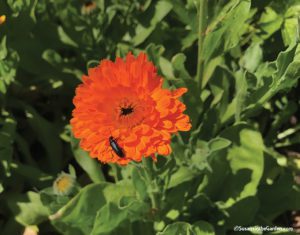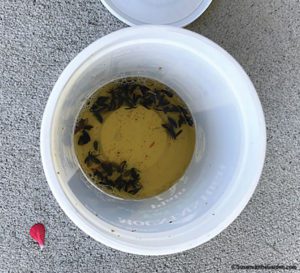Dealing with Blister Beetles

 A long time ago, I grew calendulas at our old house. I remember seeing small black beetles on the flowers but never knew what they were. Two years ago, I started growing them again and — sure enough — those beetles are back. After doing some research, I learned they are blister beetles.
A long time ago, I grew calendulas at our old house. I remember seeing small black beetles on the flowers but never knew what they were. Two years ago, I started growing them again and — sure enough — those beetles are back. After doing some research, I learned they are blister beetles.
They get their name from the fact that they produce a caustic substance that can burn or blister one’s hands or an animal’s throat should it eat the plant they are on. Blister beetles can be found on other types of plants but calendulas (a.k.a., pot marigolds) are one of their favorites.
 These beetles love to munch on the petals of the flowers (see photo at right), making them look quite awful. And since calendula flowers are edible for us humans, the last thing you want is for them to be munched by something else!
These beetles love to munch on the petals of the flowers (see photo at right), making them look quite awful. And since calendula flowers are edible for us humans, the last thing you want is for them to be munched by something else!
I love calendulas because their flowers are bright and cheerful. But the main reason I love them in my front flower bed is because they are growing beautifully in a spot that typically stays dry… and that I haven’t been successful growing anything else in! You gotta love a plant for that, right?
After talking with a local gal who grows cut flowers, I learned she has blister beetles on her calendulas, too, and was trying to figure out if there is an organic way to control them. I did a little more research and yes, there is!
It involves hand-picking (i.e., removing the offending insect from a plant) and is a method you can use for controlling other types of insects such as tomato hornworms, Colorado potato beetles and so on.
First, I should tell you that an organic product, Spinosad, has been reported to be effective at controlling blister beetles. But you DON’T want to use it! That’s because Spinosad will kill bees, and bees are attracted to the flowers of calendulas. So don’t go that route.
But the solution to controlling them is so easy, you’re not going to believe it. What I did was to take an empty quart-size yogurt container, fill a third of it with soapy water, and then proceeded to knock the beetles off the flowers and into the water (I was wearing gloves, by the way, just to be safe).
 They didn’t struggle or fly back out, it was amazing! I got about 40 of them the first day, 5 the second, and 1 yesterday. How cool is that? I know I’ll need to monitor the flowers because there might eggs hatching soon, but I love this method because a) it’s organic, b) it’s basically free, and c) very easy. Oh, I should also mention how gratifying it is to catch them!
They didn’t struggle or fly back out, it was amazing! I got about 40 of them the first day, 5 the second, and 1 yesterday. How cool is that? I know I’ll need to monitor the flowers because there might eggs hatching soon, but I love this method because a) it’s organic, b) it’s basically free, and c) very easy. Oh, I should also mention how gratifying it is to catch them!
Scoreboard:
Me: 1, Beetles: 0
